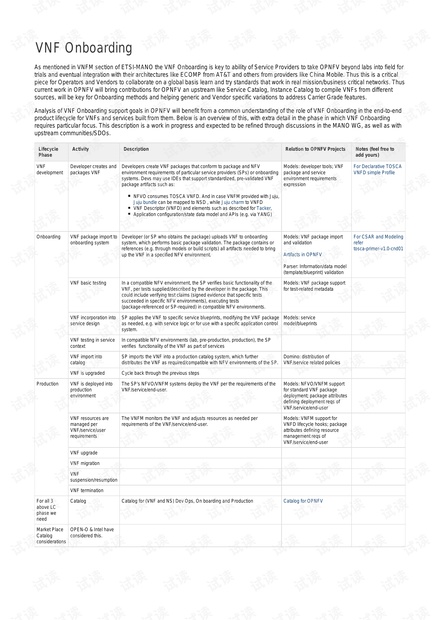没有合适的资源?快使用搜索试试~ 我知道了~
首页mano-VNFOnboarding
mano-VNFOnboarding
需积分: 9 7 下载量 55 浏览量
更新于2023-05-26
评论
收藏 63KB PDF 举报
NFV MANO 整体架构,如何建模,如何编排,描述整体NFV情况下的VNF onboarding
资源详情
资源评论
资源推荐

VNF Onboarding
As mentioned in VNFM section of ETSI-MANO the VNF Onboarding is key to ability of Service Providers to take OPNFV beyond labs into field for
trials and eventual integration with their architectures like ECOMP from AT&T and others from providers like China Mobile. Thus this is a critical
piece for Operators and Vendors to collaborate on a global basis learn and try standards that work in real mission/business critical networks. Thus
current work in OPNFV will bring contributions for OPNFV an upstream like Service Catalog, Instance Catalog to compile VNFs from different
sources, will be key for Onboarding methods and helping generic and Vendor specific variations to address Carrier Grade features.
Analysis of VNF Onboarding support goals in OPNFV will benefit from a common understanding of the role of VNF Onboarding in the end-to-end
product lifecycle for VNFs and services built from them. Below is an overview of this, with extra detail in the phase in which VNF Onboarding
requires particular focus. This description is a work in progress and expected to be refined through discussions in the MANO WG, as well as with
upstream communities/SDOs.
Lifecycle
Phase
Activity Description Relation to OPNFV Projects Notes (feel free to
add yours)
VNF
development
Developer creates and
packages VNF
Developers create VNF packages that conform to package and NFV
environment requirements of particular service providers (SPs) or onboarding
systems. Devs may use IDEs that support standardized, pre-validated VNF
package artifacts such as:
NFVO consumes TOSCA VNFD. And in case VNFM provided with Juju,
can be mapped to NSD , while to VNFDJuju bundle Juju charm
VNF Descriptor (VNFD) and elements such as described for ,Tacker
Application configuration/state data model and APIs (e.g. via YANG)
Models: developer tools; VNF
package and service
environment requirements
expression
For Declarative TOSCA
VNFD simple Profile
Onboarding VNF package import to
onboarding system
Developer (or SP who obtains the package) uploads VNF to onboarding
system, which performs basic package validation. The package contains or
references (e.g. through models or build scripts) all artifacts needed to bring
up the VNF in a specified NFV environment.
Models: VNF package import
and validation
Artifacts in OPNFV
Parser: Information/data model
(template/blueprint) validation
For CSAR and Modeling
refer
tosca-primer-v1.0-cnd01
VNF basic testing In a compatible NFV environment, the SP verifies basic functionality of the
VNF, per tests supplied/described by the developer in the package. This
could include verifying test claims (signed evidence that specific tests
succeeded in specific s), executing testsNFV environment
(package-referenced or in compatible s.SP-required) NFV environment
Models: VNF package support
for test-related metadata
VNF incorporation into
service design
SP applies the VNF to specific service blueprints, modifying the VNF package
as needed, e.g. with service logic or for use with a specific application control
system.
Models: service
model/blueprints
VNF testing in service
context
In compatible NFV environments (lab, pre-production, production), the SP
verifies functionality of the VNF as part of services
VNF import into
catalog
SP imports the VNF into a production catalog system, which further
distributes the VNF as required/compatible with NFV environments of the SP.
Domino: distribution of
VNF/service related policies
VNF is upgraded Cycle back through the previous steps
Production VNF is deployed into
production
environment
The SP's NFVO/VNFM systems deploy the VNF per the requirements of the
VNF/service/end-user.
Models: NFVO/VNFM support
for standard VNF package
deployment; package attributes
defining deployment reqs of
VNF/service/end-user
VNF resources are
managed per
VNF/service/user
requirements
The VNFM monitors the VNF and adjusts resources as needed per
requirements of the VNF/service/end-user.
Models: VNFM support for
VNFD lifecycle hooks; package
attributes defining resource
management reqs of
VNF/service/end-user
VNF upgrade
VNF migration
VNF
suspension/resumption
VNF termination
For all 3
above LC
phase we
need
Catalog Catalog for (VNF and NS) Dev Ops, On boarding and Production Catalog for OPNFV
Market Place
Catalog
considerations
OPEN-O & Intel have
considered this.
chrisopal09
- 粉丝: 0
- 资源: 3
上传资源 快速赚钱
 我的内容管理
收起
我的内容管理
收起
 我的资源
快来上传第一个资源
我的资源
快来上传第一个资源
 我的收益 登录查看自己的收益
我的收益 登录查看自己的收益 我的积分
登录查看自己的积分
我的积分
登录查看自己的积分
 我的C币
登录后查看C币余额
我的C币
登录后查看C币余额
 我的收藏
我的收藏  我的下载
我的下载  下载帮助
下载帮助

会员权益专享
最新资源
- RTL8188FU-Linux-v5.7.4.2-36687.20200602.tar(20765).gz
- c++校园超市商品信息管理系统课程设计说明书(含源代码) (2).pdf
- 建筑供配电系统相关课件.pptx
- 企业管理规章制度及管理模式.doc
- vb打开摄像头.doc
- 云计算-可信计算中认证协议改进方案.pdf
- [详细完整版]单片机编程4.ppt
- c语言常用算法.pdf
- c++经典程序代码大全.pdf
- 单片机数字时钟资料.doc
- 11项目管理前沿1.0.pptx
- 基于ssm的“魅力”繁峙宣传网站的设计与实现论文.doc
- 智慧交通综合解决方案.pptx
- 建筑防潮设计-PowerPointPresentati.pptx
- SPC统计过程控制程序.pptx
- SPC统计方法基础知识.pptx
资源上传下载、课程学习等过程中有任何疑问或建议,欢迎提出宝贵意见哦~我们会及时处理!
点击此处反馈



安全验证
文档复制为VIP权益,开通VIP直接复制
 信息提交成功
信息提交成功
评论0